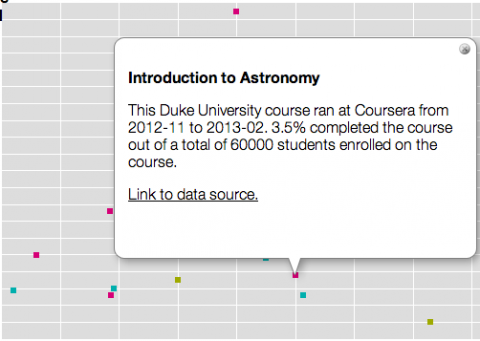MOOCs
Try to Break the Language Barrier
Next up for online education portals
Coursera and edX:
breaking into the non-English
speaking world. To be truly global,
they need to expand
their reach.
Coursera and edX:
breaking into the non-English
speaking world. To be truly global,
they need to expand
their reach.
_______________________________________________________________________________
http://www.openculture.com/2013/04/10_reasons_you_didnt_complete_a_mooc.html
MOOC Interrupted: Top 10 Reasons Our Readers Didn’t Finish a Massive Open Online Course
On Tuesday, we gave you a Visualization of the Big Problem for MOOCs, which comes down to this: low completion rates. To be clear, the completion rates aren’t so much a problem for you; they’re more a problem for the MOOC providers and their business models. But let’s not get bogged down in that. We ended our post by asking you to share your own experience with MOOCs — particularly, to tell us why you started and stopped a MOOC. We got close to 50 thoughtful responses. And below we’ve summarized the 10 most commonly-cited reasons. Here they are:
1.) Takes Too Much Time: Sometimes you enroll in a MOOC, only to discover that it takes way too much time. “Just didn’t have time to do all the work.” “As a full-time working adult, I found it exceedingly difficult to watch hours upon hours of video lectures.” That’s a refrain we heard again and again.
2.) Assumes Too Much Knowledge: Other times you enroll in a MOOC, only to find that it requires too much base knowledge, like a knowledge of advanced mathematics. That makes the course an instant non-starter. So you opt out. Simple as that.
3.) Too Basic, Not Really at the Level of Stanford, Oxford and MIT: On the flip side, some say that their MOOCs weren’t really operating on a serious university level. The coursework was too easy, the workload and assignments weren’t high enough. A literature course felt more like a glorified book club. In short, the courses weren’t the real university deal.
4.) Lecture Fatigue: MOOCs often rely on formal video lectures, which, for many of you, is an“obsolete and inefficient format.” And they’re just sometimes boring. MOOCs would be better served if they relied more heavily on interactive forms of pedagogy. Val put it well when she said, “We should not try to bring a brick and mortar lecture to your living room. Use the resources available and make the learning engaging with shorter segments…. The goal should be to teach and teach better. If one of these online universities can figure that out, then the money will follow.”
5.) Poor Course Design: You signed up for a MOOC and didn’t know how to get going. One student related his experience: “From day one I had no idea what I was supposed to do. There were instructions all over the place. Groups to join with phantom members that never commented or interacted, and a syllabus that was being revised as the course went through it’s first week.”
6.) Clunky Community/Communication Tools: This has been the Achilles’ heel of online learning for years, and so far the MOOCs haven’t quite figured it out. It’s not unusual to hear this kind of comment from students: “I find that the discussion forums aren’t very useful or engaging. They are not a very good substitute for active in-class discussion.”
7.) Bad Peer Review & Trolls: Because MOOCs are so big, you often don’t get feedback from the professor. Instead you get it from algorithms and peers. And sometimes the peers can be less than constructive. One reader writes: “I chose to stop doing the peer response section of the class due to some students being treated rudely [by other students]; in fact, the entire peer response section of the class is done in a way I would NEVER have asked of students in a classroom…. [T]here is no involvement of the professor or TA’s in monitoring the TORRENT of complaints about peer reviews.”
8.) Surprised by Hidden Costs: Sometimes you discover that free MOOCs aren’t exactly free. They have hidden costs. Brooke dropped her MOOC when she realized that the readings were from the professor’s expensive textbook.
9.) You’re Just Shopping Around: You shop for courses, which involves registering for many courses, keeping some, and dropping others. That inflates the low completion rate, but it gives you freedom. As one reader said, “I am very, very happy about being able to be so picky.”
10.) You’re There to Learn, Not for the Credential at the End: Sometimes you do everything (watch the videos, do the readings, etc.) but take the final exam. In a certain way, you’re auditing, which suits many of you just fine. It’s precisely what you want to do. But that, too, makes the low completion rates look worse than they maybe are.
Thanks to everyone who took the time to participate. We really appreciate it! And if you’re looking for a new MOOC, don’t miss our list, 300 Free MOOCs from Great Universities (Many Offering Certificates).






No comments:
Post a Comment